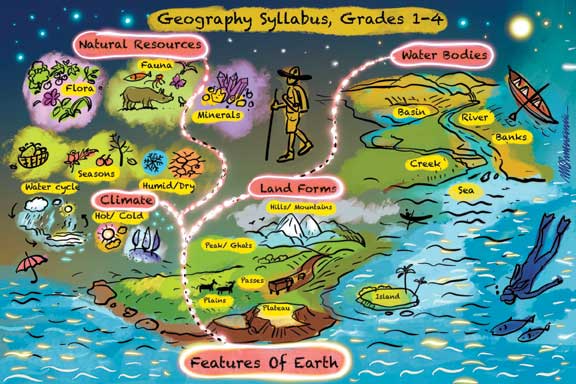Devika Nadig
The journey of a thousand miles began with the launch of Shikshangan in 2008 and continued much beyond this distance by covering the length, breadth and depth of our country. In the course of these journeys and the many interactions they brought, Vijay and I learned from individuals, communities and multiple stakeholders in the education landscape. I reckoned it would make sense to share these experiences with a wider audience with the aim of documentation and a hope that these Edulogues – travelogues seasoned with dialogue – will both entertain and educate. Each tour was unique and I hope my storytelling skills will amuse and not lose – readers.
Some of our travels took us to ancient temple towns, creating the opportunity for encounters that made me confront my own ambiguous relationship with religion, but in the process, led me to interesting discoveries – about myself and my teaching practice.
Second stop – Ambuja Vidya Mandir – Kodinar – Gujarat – 2010
The Centaur Hotel near the Santacruz Airport in Mumbai was stamped as being an unlucky spot by Vaastu experts, doomed to be deserted every few years by whoever started business there because of its round structure. Many say the same about our round Parliament building! Undaunted by this reputation, we braced the evil Vaastu and set up a meeting at the Centaur Hotel with the lanky Brij Bharadwaj who sauntered in languidly on a hot “Bombay” afternoon to meet Vijay and me. Brij was then in charge of teacher development for all the Ambuja Vidya Niketan schools, nestling placidly in the townships across the country wherever the Ambuja Cement factories stood.

Between 2010 and 2015, we visited and coached teachers in the Vidya Niketan Schools within Ambuja Cement townships in Kodinar (Gujarat), Beaver (Rajasthan) and Baloda Bazaar (Chattisgarh). We also conducted learning level assessments in the government schools that were the beneficiaries of Ambuja Foundation’s CSR interventions in Darlaghat (Himachal) and Chandrapur (Maharashtra). This memoir is from one of the earliest Ambuja Pehelwan experiences – this is the way all Ambuja employees address the Giant who is the mascot for the cement brand!
Township life is quiet and the community is closely bonded. Days at the schools used to be full of fanfare of the nariyal and gendaphool garland welcomes, and a highly motivated teaching staff focused on the novel technique of syllabus mapping we introduced them to, with an ardent desire to learn and grow. Syllabus Mapping is a unique strategy of showing progression of concepts and skills from one grade level to another, thus presenting a full picture of the main strands in all subjects.
I found it unique that most of the teachers were from families of the officers who worked with the cement company and many of them had their children enrolled in the school. Could that be the chief motivation for keeping them on the ball for learning? As a trainer, it was exciting to see a spurred-on bunch of trainees, regardless of the source of their motivation.
The evening meals at the community dining hall gave us interesting insights into township life and left me envious of the simple joys shared by factory staff and their families. I was amazed at the reach of ambition some parents expressed back then – pointing to the smoke coming out of the cement factory chimneys, they pinned their hope on their children becoming high placed officers right there… it seemed they were oblivious to the world outside!

My spirit of eager exploration knew of the revered shrine of Somnath – considered to be the first holy jyotirling of the renowned twelve – being a decent driving distance away, and the valedictory was hardly done with, as we drove off for a darshan. The stunning location of the temple surrounded by the expanse of the Arabian Sea filled me with awe, with the restored modern complex of the Somnath temple being meticulously maintained by Ambuja Cement Foundation.
Time stood still and there seemed to be no hurry to enter the temple, the calming and cool westerly breeze compelling us to relax from the training drain. For a brief moment it seemed as if I was the first explorer to arrive at these shores, the vast complex not allowing you to see any inhabitation. Just you… and miles and miles of calm waters, inspiring you to find infinity in the solitude.
History was pulled out of the long-term memory, as I recounted all hearsay about the unending plunder of this shrine by invaders starting from Mahmud of Ghazni in 1026 AD and continuing to the Mughal, Aurangzeb in 1665 AD. A brief discussion ensued on how many years of plunder it signified, and how many years of relentless restoration. Drawing on our common interest in history, Vijay and I talked about the role of Mahatma Gandhi, Sardar Patel and KM Munshi in the Somnath restoration post Indian independence, and the presence of the first President of India, Dr Rajendra Prasad, at the installation ceremony of the new shrine, in spite of Pandit Nehru’s opposition.
The sanctum sanctorum was beautifully adorned externally. It tugged at my heart and I entered solemnly, standing alone in paused prayer, seeking the internal spirit in the representative Lingam – and though I dipped into all my being and spiritual awareness, I was left with the empty feeling that the Lord wasn’t there at all…
The author has been engaged in the domain of school education for the past three decades. She is the co-founder of Shikshangan Education Initiatives, Pune, along with Vijay Gupta. The scope of their work includes teacher development by sharpening pedagogical skills and working with school leaders on their instructional and organizational leadership skills. She can be reached at
